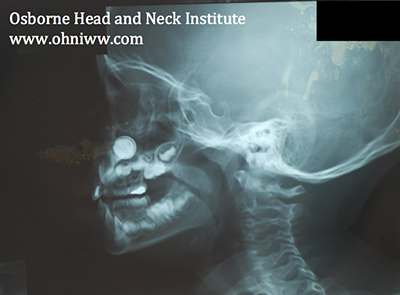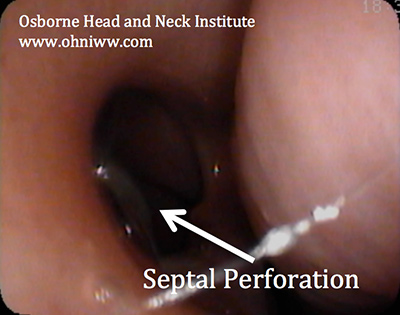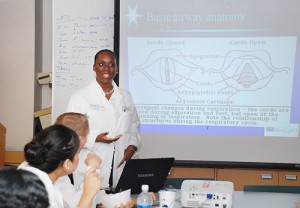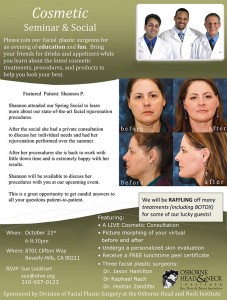- Hereditary Hemorrhagic Telangiectasia - May 25, 2016
- Hereditary Hemorrhagic Telangiectasia: Septal Perforation and Nose Bleeds - May 23, 2016
- Hereditary Hemorrhagic Telangiectasia: Epistaxis and Septal Perforation - May 18, 2016
- Wegener’s Granulomatosis: Autoimmune Disease and Multi-Focal Septal Perforation - May 9, 2016
- Kyle Korver: Facial Injury and Nasal Fracture - March 24, 2015
- Russell Westbrook: Facial Injury and Surgery - March 5, 2015
- Mega-perforation: Pushing the Limits of Septal Perforation Repair - November 26, 2014
- Septoplasty Complication and Septal Perforation - November 24, 2014
- Nose Picking (Rhinotillexis) and Septal Perforations: Why I should stop picking my nose…? - November 24, 2014
- Nasal Fractures, Septal Hematoma, and Septal Perforation: Simultaneous Rhinoplasty and Septal Perforation Repair - October 1, 2014
Lithium Battery Causing Septal Perforation/Nasal Septum Repair/Septal Perforation Surgery
CLINICAL CHALLENGE
Septal perforations can arise from a variety of injuries to the nose. In the pediatric population children placing small objects in the nose is a common cause of injury to the nasal septum. In this case a lithium battery from a small toy was placed in the nose. The battery went undiagnosed for three days and began to leak, eroding through the septum lining and cartilage, leaving the child with a septal perforation.

SURGICAL CONSIDERATIONS
In the pediatric population reconstructive nasal surgery is typically delayed for as long as possible to allow the nasal structures to fully develop . Operating too soon is thought to potentially adversily effect the growth centers of the face which could lead to further nasal deformity in adult life. Although reports are conflicting, it is generally accepted that the safer route is to wait until a patient has completed puberty before operating on the nose, save for emergency or urgent conditions where the benefits may out weigh the risk.

CLINICAL RESULTS
Septal perforations that are asymptomatic and stable in size can generally be managed medically in the pediatric population. Surgery is reserved for larger, symptomatic perforations or for those that have failed medical management. A closed endonasal approached is perferred versus the open rhinoplasty technique. Whether medical or surgical management is chosen close follow-up is mandatory to achieve the best outcome for the patient.

SURGEON COMMENTS
Dr. Hamilton – “Batteries pose a significant danger to the airway and the gastrointestinal tract of children, and although it may be impossible to prevent children from placing objects in the nose, batteries should be managed vigilantly in the household. Best practices for parents are to avoid toys that function on small lithium batterys altogether. If toys are not in use regularly the batteries should be removed as then tend to corrode overtime and may pose a danger to children even if note directly ingested. Any suspicion of and ingested battery or foreign object in the ear canal of nose should promptly be investigated by a physician. If the battery is not located by physical exam and x-ray is mandatory to rule out a illusive battery.”
Dr. Jason Hamilton is the Director of Plastic and Reconstructive Surgery for the Osborne Head and Neck Institute, and is double board certified by the American Board of Facial Plastic and Reconstructive Surgery and the American Board of Otolaryngology/Head and Neck Surgery. Dr. Hamilton is one of only handful of septal perforation specialist worldwide
For more information on the deviated septum, septoplasty, functional rhinoplasty and septal perforation repair by Dr. Jason Hamilton, septal perforation specialist, please contact the Osborne Head and Neck Institute or visit www.perforatedseptum.com.
1. “LR44 Button Cell Battery IEC Standard Version” by Lead holder – Originally uploaded by “Lead holder” to Commons overwriting File:LR44_Button_Cell_Battery.jpg (see image history for details). Licensed under Public domain via Wikimedia Commons – http://commons.wikimedia.org/wiki/File:LR44_Button_Cell_Battery_IEC_Standard_Version.jpg#mediaviewer/File:LR44_Button_Cell_Battery_IEC_Standard_Version.jpg



